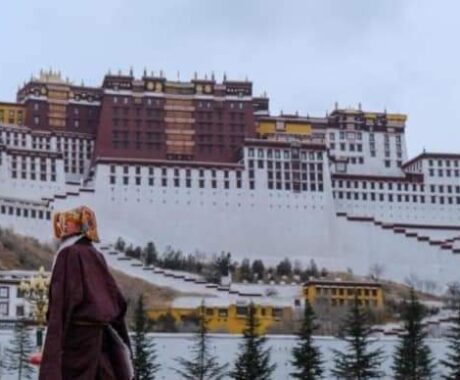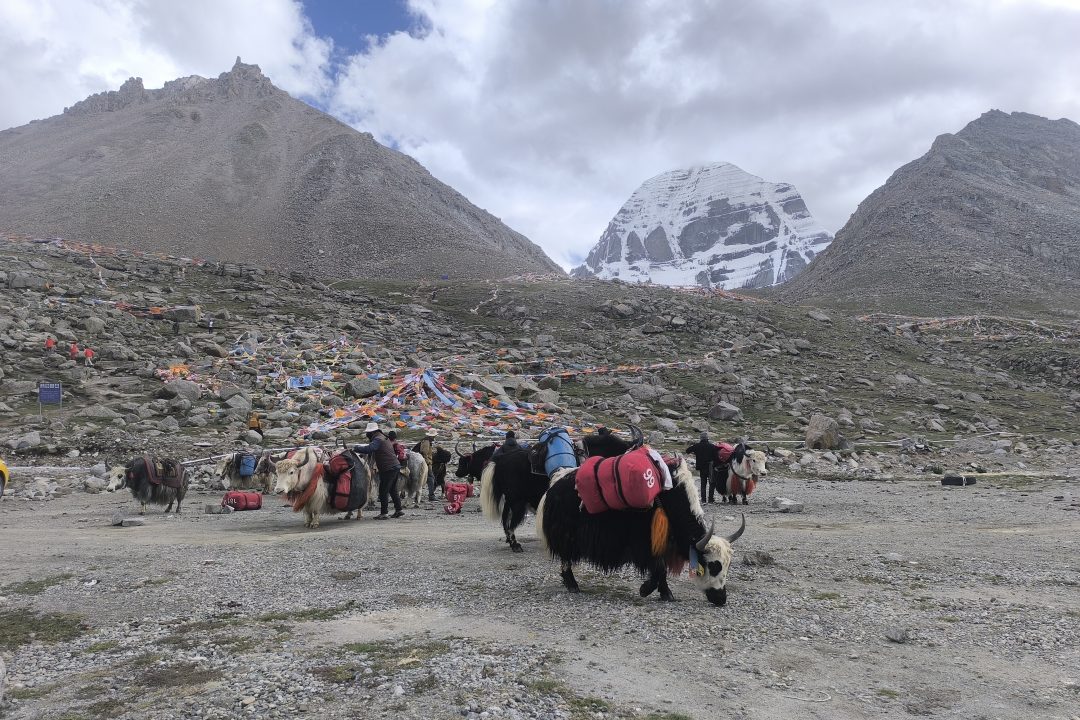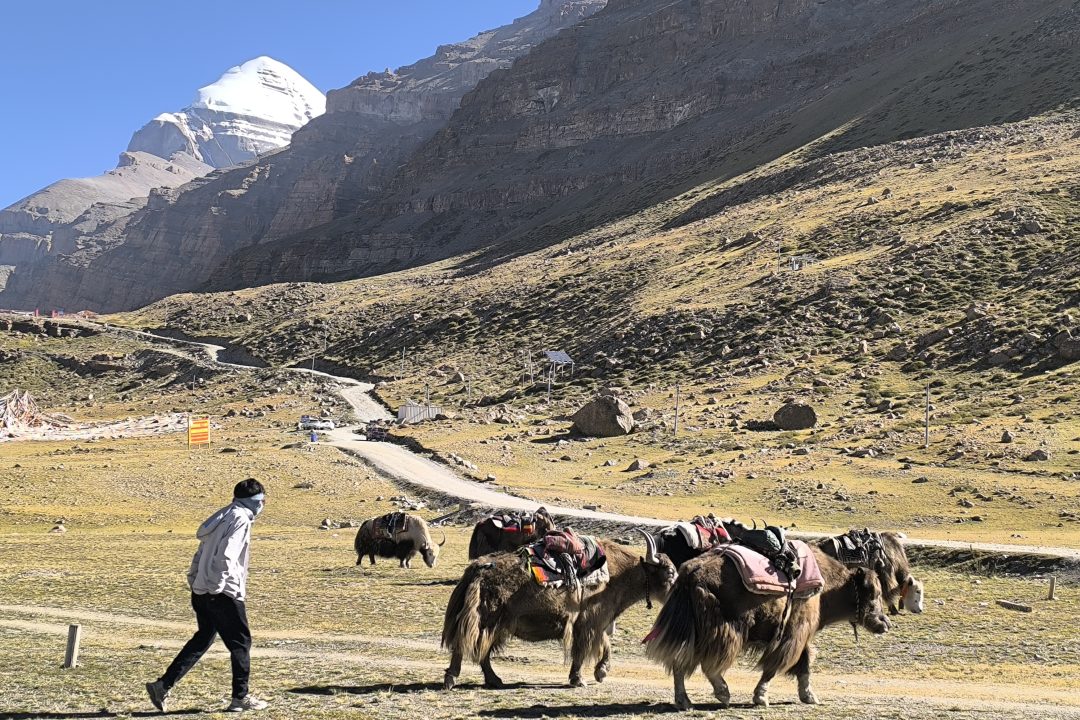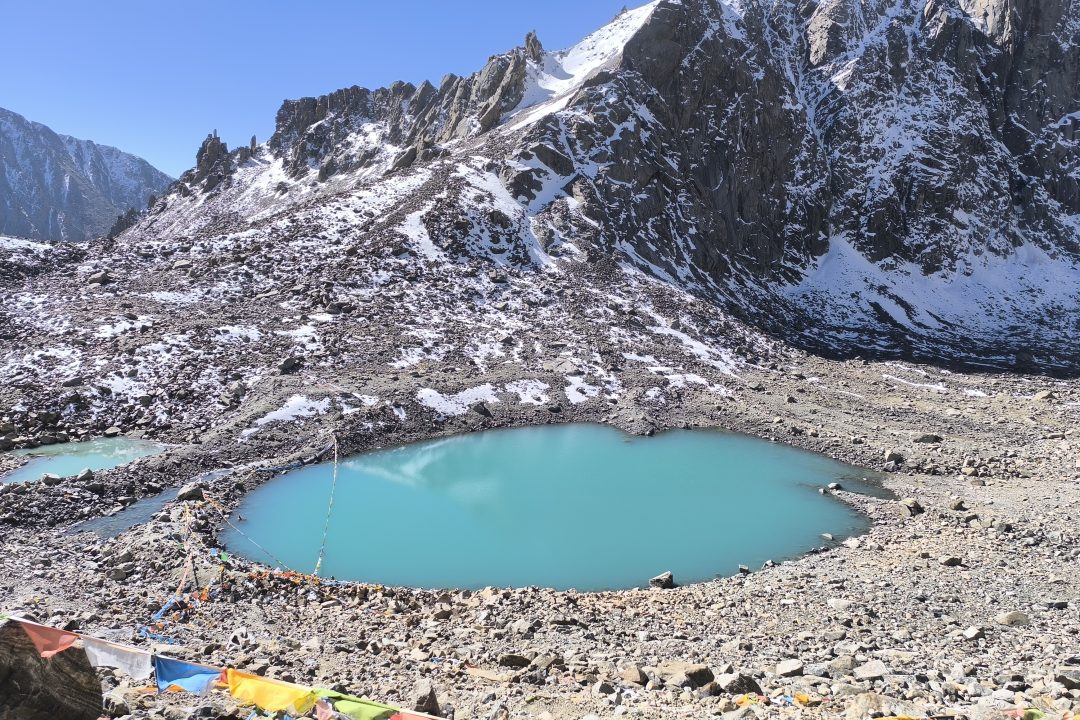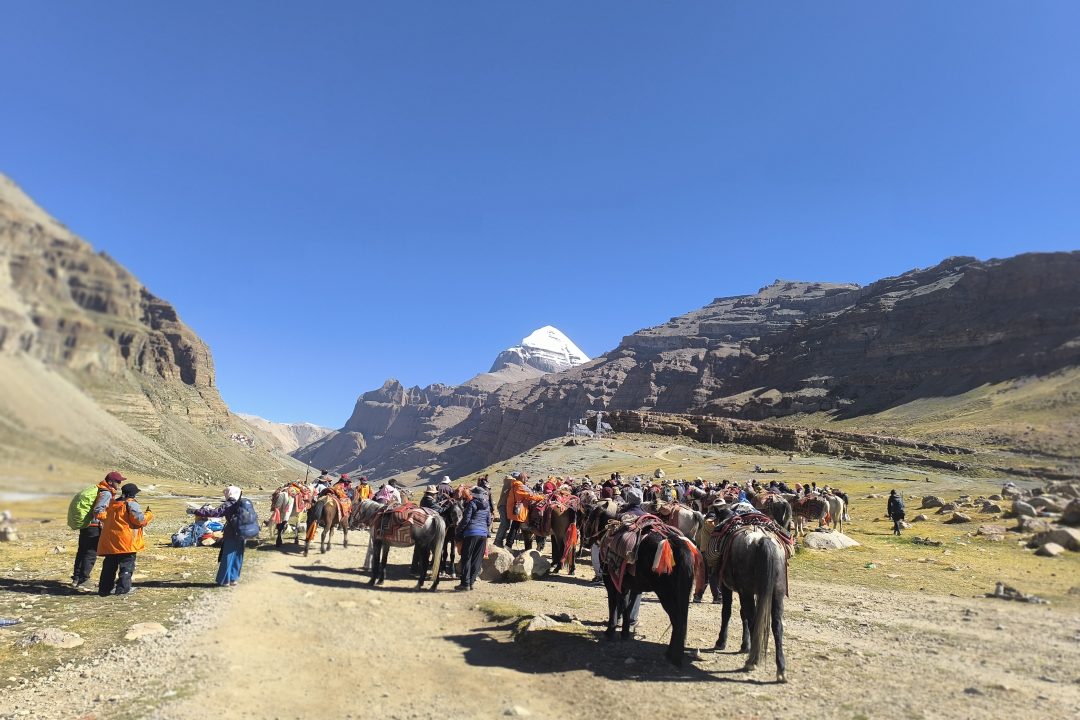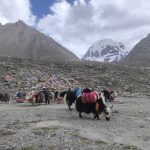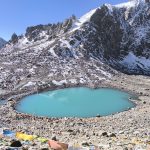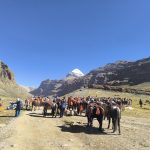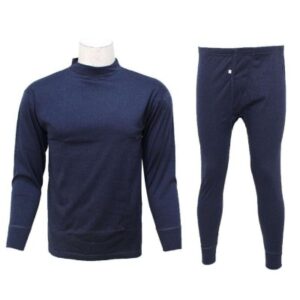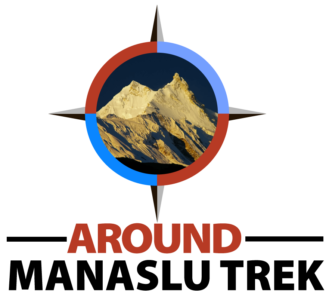Kailash Mansarovar Tour
Trip Facts
Trip Highlights
- Sacred Spiritual Journey: Experience the spiritual significance of Mount Kailash and Manasarovar Lake, two of the most revered places in Hinduism, Buddhism, and Jainism.
- Tibetan Cultural Immersion: Visit historical sites like Pashupatinath Temple and Swayambhunath (Monkey Temple) in Kathmandu, while crossing into Tibet, experiencing Tibetan hospitality and traditions.
- Scenic Drives & Helicopter Tours: Enjoy breathtaking scenic drives through the Himalayan ranges, and opt for helicopter tours to Muktinath and Gosainkunda Lake for a unique perspective of these mystical places.
- Mount Kailash Inner Kora Trek: Embark on the Inner Kora around Mount Kailash, a sacred trek offering spiritual connection, beautiful landscapes, and a challenge to test your physical endurance.
- Dolma La Pass: Trek the Dolma La Pass at 5,600m, one of the highest points of the journey, offering spectacular views of the Tibetan plateau.
- Rest Days and Spiritual Ceremonies: Partake in spiritual rituals like Puja, Havan, and Parikrama at Mansarovar Lake, along with ample rest days for acclimatization and reflection.
Introduction
The Kailash Mansarovar Tour is a pilgrimage to Mount Kailash and Lake Mansarovar in Tibet. This sacred mountain and lake are an important pilgrimage site for four religions – Hinduism, Buddhism, Jainism, and Bon. The tour usually starts from Kathmandu, Nepal. From there, travelers fly/drive to Tibet and drive to the city of Darchen, the starting point of the Kailash trek.
Travelers first visit Lake Mansarovar, which is revered for its pure blue waters. Bathing in the icy waters is considered purifying. The turquoise lake surrounded by snow-capped peaks is a breathtaking sight. The region is very remote, with an average elevation of 4,500 meters. Staying hydrated and avoiding over-exertion is important.
After the Lake Mansarovar visit, the tour’s highlight is doing a 3-day trek around Mount Kailash. This involves walking about 53 km while admiring the stunning views of the sacred mountain. Pilgrims believe that completing one round of the mountain will wipe away all sins. The trek requires being in good physical shape as it involves high-altitude hiking. Porters and horses are available to assist.

The tour usually takes around 12 days. Accommodation is arranged in basic guest houses run by Tibetans. Meals are simple, with limited vegetarian options. Travelers should carry enough warm clothing, sunscreen, sunglasses, etc. Visiting Mount Kailash is a profound spiritual experience for both pilgrims and tourists. The stunning natural beauty of the region also makes the Kailash Mansarovar Tour a memorable trip.
About Mount Kailash
- Mount Kailash, located in the remote Tibetan Plateau, is considered a sacred mountain by four major religions – Buddhism, Hinduism, Bon and Jainism. At an elevation of 6638 meters, Mount Kailash stands tall amidst the majestic Himalayan mountains.
- For Hindus, Mount Kailash is the legendary abode of Lord Shiva and his wife Parvati. It is referred to as the central point of the world and is revered as one of the greatest pilgrimage sites. Hindus believe that making a religious circuit of the 53 km route around Mount Kailash, known as the ‘Kailash Parikrama,’ will bring salvation.
- Tibetan Buddhists revere Mount Kailash as the dwelling place of Demchog and his consort, Dorje Phagmo. It is considered a gigantic mandala and the abode of Guru Rinpoche, who is believed to have brought Buddhism to Tibet. Pilgrims walk clockwise around the mountain known as the ‘Kailash Kora.‘ This holds deep spiritual significance.
- The indigenous Bon religion of Tibet regards Mount Kailash as the abode of their sky goddess Sipaimen. It is seen as a giant mandala central to their tantric rituals. Bonpo pilgrims circumambulate the mountain counter-clockwise.
- For Jains, Mount Kailash is called Asthapada and is the site where Rishabanatha, the first Jain Tirthankara, attained liberation. The two lakes near Mount Kailash – Lake Mansarovar and Rakshastal – are also considered holy.
- Mount Kailash attracts spiritual seekers from various faiths, known as the ‘navel of the universe.’ The journey to this sacred mountain provides a blissful, enriching experience as pilgrims connect with ancient stories and legenth tranquil serenity of Mount Kailash makes it timelessly holy.
Outline Itinerary
Day 01: Arrival in Kathmandu (1,300m)
Day 02: Pashupatinath & Guhyeshwari Darshan + Visa Formalities
Day 03: Doleshwor Mahadev & Bhaktapur Sightseeing
Day 04: Chandragiri Cable Car & Swayambhunath
Day 05: Dakshinkali Temple & Patan Durbar Square
Day 06: Drive to Kerung (Nepal-Tibet Border)
Day 07: Drive to Saga (4500m)
Day 08: Rest Day in Saga (Acclimatization)
Day 09: Drive to Lake Mansarovar (4,560m)
Day 10: Mansarovar Puja + Drive to Darchen via Tirthapuri (4,310 m)
Day 11: Acclimatization + Nandi Hike
Day 12: Drive to Yamdwar – Begin Kailash Parikrama (4,724 m)
Day 13: Rest Day at Dirapuk (5,210 m)
Day 14: Trek to Zuthulpuk via Dolma La Pass (5630m)
Day 15: Complete Parikrama – Return to Darchen (4,575m)
Day 16: Drive Back to Saga
Day 17: Drive to Kerung – Cross Border – Drive to Kathmandu
Day 18: Rest Day in Kathmandu
Day 19: Free Day in Kathmandu
Day 20: Departure from Kathmandu
Mount Kailash Manasarovar Yatra 2026 – Fixed Departure Schedule
| Arrival in Nepal | Visa Submission | Departure to Tibet | Return to Kathmandu | Departure from Nepal |
|---|---|---|---|---|
| 10 May 2026 | 11 May 2026 | 15 May 2026 | 26 May 2026 | 29 May 2026 |
| 02 June 2026 | 03 June 2026 | 07 June 2026 | 18 June 2026 | 21 June 2026 |
| 25 June 2026 | 26 June 2026 | 30 June 2026 | 11 July 2026 | 14 July 2026 |
| 13 July 2026 | 14 July 2026 | 18 July 2026 | 29 July 2026 | 01 August 2026 |
| 03 August 2026 | 04 August 2026 | 08 August 2026 | 19 August 2026 | 22 August 2026 |
| 25 August 2026 | 26 August 2026 | 30 August 2026 | 10 September 2026 | 13 September 2026 |
| 14 September 2026 | 15 September 2026 | 19 September 2026 | 30 September 2026 | 03 October 2026 |
Alternative Treks Around Kailash Mansarovar Tour
The Kailash Mansarovar Tour is a deeply spiritual and breathtaking journey, attracting travelers seeking both adventure and religious significance. However, if you’re looking for an alternative that offers similar cultural depth, high-altitude landscapes, and sacred experiences, here are some excellent options:
- Lhasa – Everest Base Camp – Manasarovar – Tirthapuri and Mt Kailash Parikrama Tour – 23 Days: A similar sacred and adventurous experience, combining Tibetan culture, Everest views, and a visit to Mount Kailash.
- Nepal & Tibet Overland Tour – 18 Days: A great alternative that explores Nepal’s cultural treasures and Tibet’s spiritual beauty, including Mount Kailash.
- Bhutan Tour – 5 Night 6 Days: A peaceful alternative, offering a blend of spiritual sites and Himalayan views in Bhutan.
Detailed Itinerary
-
Day 01: Arrival in Kathmandu (1,300m)
Activity: Arrival at Tribhuvan International Airport, Kathmandu.
- Transfer: Pick-up and transfer to Hotel Hilton.
- Meals: Dinner included (AP Plan).
Briefing: Rest and acclimatization at hotel. Evening group introduction
Altitude: 1,300Meals: DinnerAccommodation: 5 star hotel in Kathmandu -
Day 2: Pashupatinath & Guhyeshwari Darshan + Visa Formalities
Morning:
- VIP Darshan at Pashupatinath Temple.
- Special Rudra Abhishek Puja performed by trained priests.
- Visit Guhyeshwari Temple (one of Shakti Peeths).
Afternoon:
- Lunch at hotel.
- Complete Chinese visa form & biometric formalities.
Evening:
- Yatra briefing: Guidelines, clothing checklist, high-altitude precautions.
Altitude: 1300Meals: Breakfast, Lunch, DinnerAccommodation: 5 star hotel in Kathmandu -
Day 3: Doleshwor Mahadev & Bhaktapur Sightseeing
Morning:
- Darshan of Doleshwor Mahadev (believed to be the head of Kedarnath).
- Sightseeing of Bhaktapur Durbar Square – heritage town.
Afternoon:
- Lunch at hotel.
- Visit to Budhanilkantha (Sleeping Vishnu).
- Optional visit to Swayambhunath (Buddha Stupa).
- Optional: Those going to Muktinath (extra cost) can depart for flight arrangements.
Altitude: 1300Meals: Breakfast, Lunch, DinnerAccommodation: 5 star hotel in Kathmandu -
Day 4: Chandragiri Cable Car & Swayambhunath
Morning:
- Cable car ride to Chandragiri Hill (amazing views of the Himalayas).
- Visit Swayambhunath (Monkey Temple).
Afternoon:
- Lunch at hotel.
- Visit Kathmandu Durbar Square and Kumari Ghar (Living Goddess).
Altitude: 1300Meals: Breakfast, Lunch, DinnerAccommodation: 5 star hotel in Kathmandu -
Day 5: Dakshinkali Temple & Patan Durbar Square
Morning:
- Drive to Dakshinkali Temple (powerful Kali Shakti Peeth).
- Darshan of Devi Temple.
Afternoon:
- Visit Patan Durbar Square.
- Lunch and final packing for the Kailash Yatra.
Altitude: 1300Meals: Breakfast, Lunch, DinnerAccommodation: 5 star hotel in Kathmandu -
Day 6: Drive to Kerung (Nepal-Tibet Border)
Early Morning:
- Depart for Rasuwagadhi border.
Afternoon:
- Cross border into Tibet (China) after immigration.
- Drive to Kerung (3000m).
- Meals: Meals prepared by own Nepali kitchen team (start of vegetarian sattvic food).
Altitude: 3000Meals: Breakfast, Lunch, DinnerAccommodation: 3 star hotel in Kerung -
Day 7: Drive to Saga (4500m)
Scenic Drive:
- Cross Kerung Valley, high altitude pass (~5300m).
- Views of Ganesh Himal, Langtang Himal ranges.
- Duration: 8-hour drive with breaks.
- Meals: Kitchen team meals.
Altitude: 4500Meals: Breakfast, Lunch, DinnerAccommodation: Hotel/Guesthouse -
Day 8: Rest Day in Saga (Acclimatization)
Purpose: Rest & acclimatization to 4500m altitude.
- Optional walk in local area to help body adjust.
- Briefing on high-altitude symptoms & oxygen use.
- Meals: All meals by kitchen team.
Altitude: 4500Meals: Breakfast, Lunch, DinnerAccommodation: Hotel/Guesthouse -
Day 9: Drive to Lake Mansarovar (4560m)
Journey:
- Scenic drive to Lake Mansarovar, with views of snow-capped mountains.
- First view of Mount Kailash (weather permitting).
Activities:
- Holy dip in Mansarovar Lake (if conditions permit).
- Meals: Lunch en route, dinner at guesthouse/kitchen team food.
Altitude: 4500Meals: Breakfast, Lunch, DinnerAccommodation: Guesthouse -
Day 10: Mansarovar Puja + Drive to Darchen via Tirthapuri
Morning:
- Havan and Puja on the banks of Lake Mansarovar.
- Fill holy water.
Afternoon:
- Drive to Tirthapuri (associated with Parvati & Shiva).
- Continue to Darchen (base camp of Kailash).
Altitude: 4500Meals: Breakfast, Lunch, DinnerAccommodation: Guesthouse -
Day 11: Acclimatization + Nandi Hike
Activity:
- Short hike to Nandi Parvat base area.
- Rest and gear check.
- Purpose: Prepare body for Kora (parikrama) starting next day.
- Meals: Kitchen team food.
Altitude: 4800mMeals: Breakfast, Lunch, DinnerAccommodation: Guesthouse -
Day 12: Drive to Yamdwar – Begin Kailash Parikrama
Drive to Yamdwar (gateway to Kailash Parikrama).
- Begin trek/horse ride to Dirapuk (approx. 12km, 6–7 hrs).
- Highlight: Close-up north face of Mount Kailash.
Altitude: 4900Meals: Breakfast, Lunch, DinnerAccommodation: Guesthouse/tent -
Day 13: Rest Day at Dirapuk
Optional:
- Hike to Charan Sparsha (feet of Mount Kailash), subject to weather & health.
- Meals: Kitchen team food.
Altitude: 4900Meals: Breakfast, Lunch, DinnerAccommodation: Guesthouse -
Day 14: Trek to Zuthulpuk via Dolma La Pass (5630m)
Challenging Day:
- Steep ascent to Dolma La Pass (highest point of the Yatra).
- Descend via Gauri Kund to Zuthulpuk/ Juthulpuk.
- Trek Distance: ~22 km, 10–12 hrs.
Altitude: 4900Meals: Breakfast, Lunch, DinnerAccommodation: Guesthouse/tent -
Day 15: Complete Parikrama – Return to Darchen
Trek final leg of Kora (~8 km).
- Drive from trek endpoint back to Darchen.
- Rest and Recovery.
- Meals: Full meals by kitchen team.
Altitude: 4800Meals: Breakfast, Lunch, DinnerAccommodation: 3 star hotel in Darchen -
Day 16: Drive Back to Saga
Full day drive back across Tibetan plateau.
- Return to Saga for overnight stay.
Altitude: 4500Meals: Breakfast, Lunch, DinnerAccommodation: Hotel/Guesthouse -
Day 17: Drive to Kerung – Cross Border – Drive to Kathmandu
Morning:
- Drive to Rasuwagadhi border.
- Complete immigration and return to Nepal side.
- Optional: Helicopter ride to Kathmandu (additional cost).
- Drive to Kathmandu and check into hotel.
Altitude: 1300Meals: Breakfast, Lunch, DinnerAccommodation: 5 star hotel in Kathmandu -
Day 18: Rest Day in Kathmandu
Rest and Recovery after the pilgrimage.
- Optional massage or shopping.
Altitude: 1300Meals: Breakfast, Lunch, DinnerAccommodation: 5 star hotel in Kathmandu -
Day 19: Free Day in Kathmandu
Buffer day for delays or personal activities.
- Optional visit to local temples or spiritual sites.
Altitude: 1300Meals: Breakfast, Lunch, DinnerAccommodation: 5 star hotel in Kathmandu -
Day 20: Departure from Kathmandu
Transfer to Kathmandu International Airport.
- Farewell blessings and departure.
Altitude: 1300Meals: Breakfast
What's included
- All international arrival and departure transfers
- 7 Nights accommodation in 5-star hotels in Kathmandu on a sharing basis room (Breakfast/Lunch/ dinner)
- 1-night accommodation in Timbure inside Langtang National Park near Kerung
- Private transportation, guide, and entrance fees for one day of sightseeing in Kathmandu
- Private transfers between the Kathmandu-Nepal/Tibet border (both ways)
- Customs formalities assistance at Nepal-Tibet immigration in Kerung (Kyirong)
- Tibet/Kailash travel permits and Tibetan visa
- Transportation in Tibet/Kailash region
- Truck to transport kitchen supplies and food
- Accommodation in guest houses on a sharing basis in the Kailash region
- All vegetarian meals during the tour
- Drinking water and hot beverages
- Duffel bag and small bag for personal use
- Warm jacket (returnable after use)
- Entrance fees for Lake Mansarovar
- Licensed English-speaking Tibetan guide
- Nepali crew, coordinator, kitchen staff and helpers
- Bathing tents, kitchen supplies, and equipment
- Yaks or porters to carry goods during Kailash Kora
- Emergency evacuation management
- First aid kit and oxygen
What's not included
- Any personal expenses such as insurance, emergency evacuation charges, and personal medical expenses
- Any items not mentioned under inclusions
- Tips, laundry, telephone calls, etc.
- Side trips other than those mentioned in the itinerary
- Any meals not specified as included
- Travel Insurance
- Additional cost of upgrading the accommodation
- Visa or permit fee due to the immediate rule modification from the Tibet part
- Emergency Evacuation
- Flights to/from Kathmandu
Trekking Gears
To ensure a safe and comfortable Kailash Manasarovar Yatra, it is highly recommended to bring the appropriate equipment and gear to cope with the cold temperatures. The following is a list of essential equipment and gear, which can be purchased either in the Thamel market or brought from your home country:
Baggage
- 70-100 liters Duffle bag
For trekking and expeditions, a duffel bag is essential to pack all kinds of trekking equipment. Duffel bags come in various sizes, ranging from 60 liters to 100 liters. There are different brands available, such as The North Face, Sonam, Sherpa, Rab, and Everest Hikes. You can purchase these bags both online and offline in your homeland or in Kathmandu, particularly in Thamel's trekking shops. The cost varies depending on the brand, ranging from $15 to $100.
- Water proof day pack 30-40 liters
For hiking and trekking, you can choose from various brands of day bags. We recommend a 30 to 45-liter waterproof, strong, and good-quality day bag. Prices range from $40 to $200, depending on the brand and quality. You can purchase it in your homeland or buy it at the Thamel market (a trekking shop). Typically, this bag is used for day hiking and carries toiletries, emergency medical supplies, snacks, a water bottle, a jacket, warm shirts/t-shirts, a hat, trekking poles, and gloves.
- Pancho / Raincoat
Rain, wind, and snow are common in trekking areas. Typically, to avoid rain, we use a poncho, which also helps keep our body, clothes, and day pack dry. The cost of a raincoat is $10 to $50, depending on the quality, and it can be found in Thamel (a trekking shop). Alternatively, if possible, you can bring one from your own source.
- Power Bank / Trekking Solar
In the Himalayas, a trekking area, electricity is limited due to a small hydro power station. Sometimes, the electricity may not work, and often solar panels are used in most places. If the day is not sunny, then solar panels may not work. In that case, we can use our own backup to charge electronic devices. The quality makes the price vary from $50 up to $150. You can buy it in a Kathmandu trekking shop, or you can bring it on your own.
- Water Filter
During mountain treks, it is essential to stay hydrated by drinking either hot or cold water. The mountain water is robust and rich in minerals. Having a water filter machine allows you to filter this water. This is not only environmentally friendly but also cost-effective, as plastic bottled water can be expensive. The price range for water filters is $50 to $100, depending on the brand. You can purchase one in your own country or buy it at a Thamel trekking shop.
- Sleeping bag (comfort rated _20)
Normally, we use a sleeping bag during camping trekking and teahouse trekking. In teahouses, we are provided with blankets, but during the busy season, the blankets may not be sufficient. That's why we highly recommend owning a sleeping bag. Sleeping bags come in different types, ranging from -5 degrees to -30 degrees, and they vary in price. If you choose to buy a local Nepali product, the cost may not be expensive, ranging from Rs 5000 to Rs 20000. However, if you prefer a brand like The North Face, Sonam, Sherpa, or RAV, the cost can range from $200 to $1000. You can purchase them online or offline.
In Nepal, you have the option to rent or buy a sleeping bag. If you opt for a trekking package, the organizer will arrange sleeping bags based on different trekking areas.
- Head torch
During our Himalaya trekking, we ventured into remote areas where electricity and lighting systems were scarce, even in teahouses and high passes such as Thorang Pass, Larkey Pass, and the three high passes. In these places, especially during nighttime trips to the toilet or while crossing high passes, a headlight is essential. Headlights come in different types, including a normal one, one with a battery, or another with an electric source, ranging in cost from $10 to $50. You can purchase them online or offline, either from trekking shops in Thamel or in your home country.
- Water bottles 1 lit 2
During Himalayan trekking, it is advisable to carry two types of bottles: a 1-liter small thermos for hot water, tea, or coffee, and another 1-liter bottle for regular drinking water. The prices for these bottles range from $7 to $50. You can purchase them at Thamel trekking shops or in your home country. In Nepal, these bottles are available both online and offline.
- Sun glass (100% up protection)
During Himalayan hiking and trekking, it is essential to have sunglasses that provide protection against dust, wind, snow, cold, and heat. Different weather conditions require different types of sunglasses. We highly recommend reputable brands for sunglasses, with prices ranging from $10 to 200%. These sunglasses are readily available both online and offline. You can conveniently purchase them from trekking shops in Kathmandu Thamel or from retailers in your own country.
Clothing Essential
- Water proof jacket
During Himalaya hiking and trekking, where you may encounter rain, wind, cold, heat, dust, and snow, it is essential to invest in a high-quality waterproof jacket for protection. Various brands offer reliable options, such as The North Face, Sherpa, Sonam, Black Diamond, and RAB, with prices ranging from $100 to $500. These jackets are available for purchase both online and offline. You can find them at The Kathmandu Thamel trekking shop or in stores in your own country.
- Warm down jacket
During the trekking, we need a down jacket for cold places. We highly recommend a local or international brand depending on your budget. The cost will start from $5 and can go up to $1000. The recommended brands are "The North Face, Sonam, Black Diamond, Sherpa," which you can buy from your home country or in Kathmandu Thamel trekking shops. They are available both online and offline.
- Warm jumper
When reaching the teahouses during Himalayan treks, it is advisable to change into warmer clothes. We highly recommend bringing a jumper, and there are both local and international brands available, depending on your budget. Prices start from $30 to $120. If you already have one, that's fine; otherwise, you can purchase it in Nepal from the Thamel market, both online and offline.
- Trekking trousers
During Himalaya trekking, it is essential to have waterproof trousers to protect against rain, wind, dust, cold, and snow. We highly recommend choosing a brand based on your budget, with prices ranging from $20 to $150. Some notable trekking trouser brands include "The North Face," "Sonam," "Black Diamond," and "RAB." These trousers can be purchased both online and offline. If you already have them, you can bring them along; otherwise, you can purchase them at the Nepal Thamel Market.
- Base layer shirts
Normally, during Himalayan trekking, we use base layer shirts to protect ourselves from wind, dust, sun, and rain while hiking. There are both local and international brands available, with costs ranging from $20 to $120. You can purchase them either online or offline. If you already have one, you can bring it with you; otherwise, you can buy it at a trekking shop in Nepal.
During Himalayan trekking, the trekking areas can be extremely cold. We highly recommend purchasing a set of thermal clothing. There are both local and international brands available, such as The North Face, Sonam, Sherpa, Black Diamond, Kathmandu, and Everest. The cost can range from $50 to $250, and you can find these sets both online and offline. If you already have a set, you can use that; otherwise, we recommend buying one in Nepal, specifically at the Thamel market.
- Sunhat/warm hat/beanie
During Himalayan trekking and hiking, it is advisable to wear a sun hat to protect yourself from the sun. Additionally, when feeling cold, you can use your own woolen hat. We highly recommend purchasing either local or international brands, with prices starting from $5 and going up to $25. You can find these hats in the Thamel market in Nepal.
- Scarfs
During Himalayas trekking, it is essential to protect your neck, ears, mouth, and nose. We highly recommend purchasing different types of scarves, which are available in Nepal Thamel trekking shops. Prices start from $3 and go up to $25.
- Hiking boots
During Himalayan hiking and trekking, the most crucial equipment is footwear, particularly trekking boots. These boots are essential for safeguarding your ankles, ensuring safe walking, and being physically and mentally prepared for the trek. We highly recommend purchasing internationally recognized waterproof shoe brands such as Salomon, Hoka, Lowa, and Marmot. The cost typically starts from $150 and can go up to $400. You can find these brands in both Europe and Asia, including the Kathmandu Thamel market.
- Trekking socks / liner sock/heavy mountaineering socks
During Himalaya hiking and trekking, it is essential to have different types of socks depending on your budget. We highly recommend investing in trekking socks, with prices ranging from $3 to $30. There are both local and international brands available, and you can purchase them in Kathmandu's Thamel market
- Thermal gloves / warm / water proof gloves
During Himalayas trekking, when we experience cold weather, we use different kinds of gloves. Some gloves are thin, while others are waterproof. We highly recommend buying them, with prices starting from $10 and going up to $50, depending on your budget.
- Sun protection / Lip Gaurd
During Himalayan hiking and trekking, we encounter various weather conditions such as sun, snow, cold, and dust, which can dry out the skin and lips. In such situations, it is essential to use protection, especially if you have sun allergy. We highly recommend purchasing lip balm and sunscreen, with costs ranging from $1 to $30. These products can be bought at trekking shops in Thamel, Kathmandu.
- Wash bag toiletries
During Himalayan hiking and trekking, we consistently rely on nature for various needs. For long toilet breaks, it is essential to carry toilet paper. Whether at tea houses or during the trek, having a good quality toilet paper is crucial. We highly recommend purchasing it from Thamel trekking shops, where the cost ranges from $1 to $2.
During Himalayan hiking and trekking, where access to washing towels or hot water is limited, it is recommended to purchase wet paper. The cost starts from $2 and can go up to $8 at medical shops in Thamel.
- Travel towel
During Himalayan hiking and trekking, the hotels are not luxurious; they are based on local standards. It is advisable to carry both a large and a small towel for drying the face and body. These items can be purchased at trekking shops in Thamel, with prices ranging from $2 to $20.
- Small pad lock to lock your bag
While hiking and trekking in the Himalayas, our duffel bag is carried by the porter. It is advisable to secure all your equipment inside the bag with a lock. We highly recommend purchasing a small lock, with costs ranging from $1 to $5, which can be found in Kathmandu's trekking shops.
- Medical Kits
During Himalayas hiking and trekking, most of the time, we are in remote areas and need to carry a basic medical kit with us. The emergency primary medicines we should have depend on our needs. You can buy them at a medical shop in the Thamel market. The basic first aid kit should include antiseptic cream, throat lozenges, diarrhea treatment (like loperamide), altitude sickness medication (such as acetazolamide), painkillers, insect repellent, plasters, blister treatment, insect repellent, and rehydration salts like Dioralite. Additionally, it's advisable to carry glucose tablets and multi-vitamin tablets.
- Trekking pole / Sleeping bag liner / Travel clothes / Camera / Pen knife
Normally, when getting ready for Himalayan hiking and trekking, both physically and mentally, it's
essential to have trekking poles. They provide support for another leg, and there are various types available. We highly recommend investing in a good quality pole.
Inside your sleeping bag, a liner is necessary to keep warm. Before and after trekking, comfortable city clothes are essential. You can use your old ones or opt to buy new ones depending on your preference.
During the trek, capturing different angles and views with a good camera is crucial. You can use your existing one or invest in a new camera based on your budget.
In case of emergencies or for general use during the trek, it's advisable to have a Swiss small knife. You can purchase all these items at Thamel trekking shops
What Not To Pack?
- Jewelry and valuables things, Heavy zoom lenses for your camera, Too many cotton clothes/ more than one pair of jeans, Bulky towels
During Himalayan tours, including activities such as hiking, trekking, peak climbing, and expeditions, we strongly advise against bringing items such as jewelry, gold, excessive cash, large cameras, too many cotton clothes, thick towels, etc.
FAQs of Kailash Mansarovar Tour
-
What is the best time to go on the Kailash Mansarovar tour?
The best time to visit is during the spring (April - May) and autumn (September - October) months when the weather is mild and ideal for trekking. These seasons offer clear skies, beautiful views, and comfortable temperatures. -
How difficult is the Kailash Mansarovar Tour?
The parikrama of Mount Kailash is a 53 km trek that takes 2-3 days to complete. The trail takes you up to 5000 m above sea level, so it can be challenging due to the high altitude and steep inclines. But the trek can be done by anyone with a moderate fitness level. Proper acclimatization to the altitude is vital before attempting the trek. -
What facilities are provided during the yatra?
We provide comfortable transport for transfers, clean and hygienic vegetarian meals, and shared accommodation in guest houses with common washrooms and hot water supply. Oxygen, first-aid, and basic medical facilities are also available throughout the journey. A professional English-speaking guide is provided as well. -
What is the level of fitness required for this tour?
Anyone with a moderate fitness level can complete this tour, as most of the walking is gradual. However, due to high altitude, even short walks can be demanding. As long as you are comfortable walking 5-6 km per day at 5000m altitude, you will be fine. -
Can senior citizens go on this tour?
Yes, generally anyone between the ages of 15-65 years is permitted to go on this tour. We have had many enthusiastic senior citizens on our tours so far. Our team monitors the guest's health status to prevent incidents. However, it is extremely important to get proper medical screening done before the tour if you have any pre-existing conditions. Having a positive attitude also goes a long way! -
What kind of food is served on the tour?
As the tour takes you through remote areas of Tibet, only vegetarian meals are available. You will be served plain but nutritious food such as Tsampa, Momo, Thukpa, fried rice, noodles, etc. Packed lunches will be provided during the day. Avoid eating uncooked vegetables and fruits or drinking unfiltered water during the tour. Hot beverages like tea and coffee are safe to consume. -
Is travel insurance mandatory to go on this tour?
Yes, you must purchase comprehensive travel insurance to cover medical emergencies, high-altitude sickness, emergency evacuation, ambulance transportation, damage/loss of baggage, etc. Please carry your insurance documents with you during the tour. -
What distance is required for the Parikrama walk?
The parikrama or kora (circumambulation) of Mount Kailash involves a walk of around 52 kilometres spread across 2-3 days. On average, you must walk anywhere between 5-15 kilometres per day depending on your fitness levels and trekking pace. The route takes you across elevations ranging from 15,000 feet to 19,000 feet above sea level. Do not rush, and take ample resting stops. Our experienced guides set the required pace as per individual capacity to ensure you can successfully and safely complete the parikrama. Let us know if you need more details. -
How can one obtain a group visa from Nepal to Tibet?
Normally, we obtain a group visa through a government-licensed trekking agency, which then submits a proposal to the Tibetan agency. The Tibetan agency, in turn, puts forward the proposal to the local government along with all the required documents. -
What documents do we need for a Tibet visa?
For the Tibet visa system, the process is quite intricate. When planning a trip to Tibet, it is necessary to engage with a local agency and guide in Nepal. The Chinese visa application form needs to be filled out online, providing detailed information such as personal data, family background, work details, earnings, business information, a passport-sized photo, a copy of the Nepal visa, passport copy, and confirmed hotel bookings in both Nepal and Tibet. The form must be filled out personally, and the signature should be valid with the accompanying passport. -
How much time is required, and what is the cost for this trip?
Normally, we organize an 18-day tour plan from Kathmandu to Kathmandu. Due to the Chinese tour, we have to wait for 1 week in Kathmandu for visa processing. The price depends on the level of service, ranging from $3000 to $10000 for star-rated accommodations. -
How do we start the tour and trek – by overland or by flight?
Normally, there are two ways to reach Tibet: overland and by flight. The overland routes include Hilsa border, Tatopani border, and (Kerung) Rasuwagadi border. Currently, we use only the Rasuwagadi border for entry and exit. As for the flight option, the Kathmandu to Lhasa flight is still closed due to the pandemic. Presently, we use Kathmandu to Timure by helicopter for the journey and return. -
Can solo trekkers easily obtain a visa?
No, solo trekkers cannot obtain a visa. To secure a visa, they need a minimum group size of 5 people with foreign passports. -
What is the meaning of Manasarovar and Rakshas Lake?
"Manasarovar" means "Lake of Consciousness" in Sanskrit, and it is a sacred freshwater lake in Tibet, associated with Hindu and Buddhist mythology. "Rakshas" in Rakshas Lake means "demon" in Sanskrit, and it is considered a darker lake, contrasting with the spiritually significant Manasarovar, both located near Mount Kailash. -
What is the meaning of Lhasa, and how can we reach Lhasa?
"Lhasa" means "place of the gods" in Tibetan. Lhasa, the capital of Tibet, is reachable by air, train, or road. Major airports and a railway link provide access, and road journeys offer scenic routes, making Lhasa accessible for travelers. -
Where is Mount Kailash located, and how famous is it?
Mount Kailash is in the Kailash Range of the Himalayas in Tibet, China. It is extremely famous for its religious and spiritual significance, revered by Hindus, Buddhists, Jains, and Bon followers, attracting pilgrims and trekkers globally. -
Are you familiar with the 'Samudra Manthan' story, and is it related to Kailash?
Yes, the 'Samudra Manthan' or churning of the ocean is a Hindu mythological story. While it doesn't directly relate to Mount Kailash, the mountain is often associated with Lord Shiva, a key figure in the story. Kailash's significance lies in its spiritual connections across various religious traditions. -
Why do Buddhists, Hindus, and followers of other religions revere Mount Kailash?
Mount Kailash is revered by Buddhists, Hindus, and other religions for its spiritual significance as the abode of Lord Shiva in Hinduism, a sacred site in Buddhism, and a symbol of divine power and enlightenment, drawing pilgrims seeking blessings and transcendence. -
What physical and mental conditions are required for this trek?
Normally, when preparing for higher altitudes, we require sufficient physical strength and daily exercise for at least 6 months before the tour. Additionally, mental preparation is also necessary for the journey. -
What equipment do we need during this trek?
We need all the necessary trekking equipment for this trek and tour. -
How high is Mount Kailash Base Camp and Mount Kailash?
Mount Kailash Base Camp is approximately 15,092 feet (4,600 meters) above sea level. Mount Kailash, a sacred peak in the Himalayas, stands at 22,028 feet (6,714 meters), attracting pilgrims and trekkers for its spiritual significance and stunning scenery. -
Why is the Tibetan plateau referred to as a mountain desert plateau?
The Tibetan Plateau is labeled a "mountain desert plateau" due to its high elevation, arid climate, and extensive mountainous terrain. Its rain shadow effect, caused by the Himalayas, results in limited precipitation, creating a harsh and desert-like environment. -
What types of weather are found in Tibet, and why do Tibetan people only bathe three times in their entire life?
In Tibet, it is a northern Himalayan region with consistently cold weather. In the old Tibetan culture, people bathed only on three significant occasions: when they were born, when they got married, and when they died. This practice originated from the remoteness and cold climate of Tibet, where people didn't easily have access to clothes and showers. Due to their dependence on animals and lack of education, they traditionally bathed just three times in their lives. -
Do we need assistance from a Nepali organizer to travel to Tibet?
Yes, without help, we cannot enter the border. That's why we always need assistance. -
How old is Lhasa city, and why is it called the 'Golden City of the World'?
Lhasa, the capital of Tibet, is over 1,300 years old. It earned the title "Golden City of the World" due to the grandeur of its historical architecture, including the iconic Potala Palace, and its cultural significance as a center of Tibetan Buddhism. -
How difficult is Charan Sparsha and Dolma-la pass, and what is their altitude?
Charan Sparsha is situated at an altitude of 5300m above sea level, making it challenging to reach. The Dolma-La pass is also very difficult due to the lower oxygen levels, with an altitude of 5650m above sea level. -
Normally, during the Kora, depending on your time, we need a personal porter and horse for 3 to 4 days. What is the cost for this service?
Depending on your physical condition and the duration of the trek, the cost for the porter and horse will vary. According to our itinerary, the cost for a 3 nights 4 days porter and horse service will be 5100 Chinese Yuan. -
What are the Chinese rules for entering and exiting Tibet?
China has different rules for various entry points. When we enter the border, they biometrically scan us with our original permit, visa, and passport. Normally, we must exit from the same place we entered. In case of emergency, we seek assistance from a Chinese guide. -
What is the tipping rule for Tibetan drivers, guides, porters, and horsemen?
Normally, we hire porters and horsemen for 3 to 4 days, and during that time, they expect to receive 20 to 50 Chinese Yuan per day. They anticipate this money for their food and accommodation. For the Tibet tour guide and driver, the cost depends on the group size, ranging from 200 to 300 Chinese Yuan per person. -
What type of accommodation do we get during the Kora time?
During the Kora time and Manasarovar Lake time, we stay in simple tea houses where food is prepared by our own staff. There are limited varieties available for the high-altitude tour. -
Why are Tibetan places like Lhasa, Manasarovar, Tirthapuri, Charan Sparsha, Dolma-la pass, and Kailash Base Camp considered spiritual?
These Tibetan places hold spiritual significance due to their association with Buddhism and Hinduism. Lhasa is the center of Tibetan Buddhism, Manasarovar is a sacred lake, Tirthapuri is linked to Guru Rinpoche, Charan Sparsha is a pilgrimage site, Dolma-la pass is on the Kailash pilgrimage, and Kailash Base Camp is near the sacred Mount Kailash. These locations attract pilgrims seeking enlightenment and divine connection. -
How can we exchange dollars or rupees for Chinese Yuan (Renminbi)?
Normally, we can change money in Kathmandu at a money exchanger. Sometimes, if we did not change money in Kathmandu and cannot easily get Chinese Yuan (UN), we exchange it in Kerung or Lhasa with the help of a Tibetan guide. -
During the tour and trek, do we experience altitude sickness?
Normally, we start our treks and tours from Kathmandu (1300m) to Kerung (2800m), Sanga (4000m), (Manasarovar Lake) 4600m, Darchen (4800m), Dirapuk (5000m), and Dolma-La Pass (5600m). At these high altitudes, starting from 3000m, we may experience altitude sickness. During that time, we follow the guidelines and take primary medication. -
What are the emergency possibilities we have, and do we carry our own oxygen cylinder with us at all times during the tour and trek?
In any emergency cases, every local area has an ambulance, which we can use to reach a hospital. Ambulance services have different prices set by the government. All the time, when we start from Kerung and before leaving Kerung, we have our own oxygen cylinder. -
What types of people live in Tibet, and what is their lifestyle like?
All Bon Buddhist people live in this area, leading a very simple lifestyle. Everybody depends on farming, and they have yaks as domestic animals. The Chinese occupied Tibet 57 years ago. Now, the Tibetan people's lifestyle has changed, and they can easily work for money, obtaining everything they need. They have a good lifestyle. -
How do Tibetan people access education and health facilities?
Every village has a primary school, and each district has a headquarters, university, and hospital. Therefore, it is easy for them to access education and health facilities. -
How remote is Tibet, and what types of animals and birds can we expect to see during the tour and trek?
It was very remote 20-30 years ago, but nowadays, every place has a beautiful highway. In Tibet, the very famous animals are wild yak and wild donkey. Domestic animals like dogs, cows, goats, sheep, cats, yaks, and nyaks are seen during the tour. In terms of birds, we can see crows and Tibetan snow cocks. -
Why can't we take pictures at Chinese police checkpoints, and why are police with us all the time during the tour and trek?
China has a monopoly system for the military and police force, and they explicitly state that certain items should be avoided when entering certain points. This is due to security threats, which is why taking photos is not allowed. -
Do we carry any books or photos of the Dalai Lama with us?
Carrying any kind of religious pictures, photos, books, or political books related to the Dalai Lama is not allowed. -
During the Kora time, if it is snowing, how do we cross the way, and is it safe to pass?
If, during the Kora time in April, May, June, and July, heavy snow occurs depending on the weather, Tibetan Yaks open the way. During the downhill, it is not possible to ride a horse, and we have to walk down. In case of emergencies, one of our staff members will assist you in descending. Sometimes, if there is significant heavy snow, it may not be possible to pass, and it is not safe to do so. -
During the tour on the Nepal side and Tibet side, what kind of ground transportation and flights do we use?
On the Nepal side, depending on the group size and distance, we use private cars, hiace, coasters, and helicopters. On the Tibet side, we have 28-seater tourist buses, vans (12-seater), trucks, and cars. -
In Manasarovar Lake, is it possible to bathe or swim, and how do we bathe with water in the lake?
Five years ago, it was permissible to bathe inside the Manasarovar Lake. However, due to an increasing number of visitors causing pollution, the Tibetan local government has prohibited bathing and swimming. Presently, we use our own shower tent and kitchen tent, filling buckets and boiling water for bathing. -
Do we set up tents and stay overnight at Manasarovar during the nighttime?
Yes, we set up the tent and spend our night because we can witness the early morning star with the likeness of Lord Shiva's face, as described in the Shiva Purana scriptures. -
Is it possible to perform "hovan" in Manasarovar, and where can we obtain the materials for "hovan"?
Yes, it is possible. Normally, we carry our own "hovan" materials from Kathmandu, which are arranged by the Nepal tour agency or guide. -
What are the rules for tipping Nepali guides and staff?
We have a specific rule for our own staff. In your package, you should tip the staff 10-12%. -
Is a helicopter tour possible in Tibet?
No, it is not possible. Only VIPs and local government officials are allowed. -
What views can we see during the Nepal and Tibet tour?
During the flight from Kathmandu to Timure, on the right-hand side, we can witness Langtang Lirung and Dorje Lakpa, while on the left-hand side, Ganesh Himal and Paldor Himal come into view. Upon entering Tibet, the Tibetan mountain range and Shisapangma become visible. -
What kind of activities are possible during the six days of Nepal visa time?
During that time, we engage in various activities. Firstly, we process our visa forms and check them. Following that, we undertake regular sightseeing, including Pashupati Darshan, Pashupati Aarati, Shankaracharya Math Rudraavhishek. City sightseeing encompasses visits to Boudhanath Stupa, Budhanilkantha, Swyambhunath Stupa, Doleswor (Head of Kedarnath), and all the Durbar squares in Kathmandu. Further activities include Manakamana Darshan, Muktinath and Damodar Kunda helicopter tours, Gosainkunda Helicopter tour, Everest area mountain flight, and finally, the guide will conduct a trip briefing. -
Do I need special permits to visit Tibet and Mount Kailash?
Yes, you will need a Tibet Travel Permit, along with other necessary permits like the Alien's Travel Permit. The permits are arranged by the tour company. We’ll help facilitate the visa processing and required paperwork for a hassle-free journey. -
Can I visit Mount Kailash if I am not physically fit?
While the trek to Mount Kailash is physically demanding, it is doable for most people with moderate fitness levels. If you're worried about the altitude and distance, you can opt for horse rides on certain sections of the trek. It’s important to consult your doctor before starting the journey, especially for high-altitude treks. -
Is the food safe to eat during the trip?
We provide all meals (breakfast, lunch, and dinner) during the tour, cooked by our experienced kitchen crew. The food is safe, nutritious, and prepared to cater to the health and dietary needs of travelers. There are also options for vegetarian and vegan diets. -
What happens if I get sick or injured during the trip?
In case of an emergency, basic medical kits are provided. There are emergency helicopter evacuation services in place, which can be activated if necessary. However, it’s advisable to have comprehensive travel insurance covering medical emergencies and evacuation. -
How do I prepare mentally for this journey?
recommend you visualize your spiritual goals, embrace the challenge, and trust the process. It’s not only about the mountain but the insights and personal growth that come with completing the trek. Meditate before your trip and set intention-based goals for the journey. -
Do I need to be a seasoned trekker to complete this journey?
While the trek is demanding, you don't need to be an elite athlete to complete it. The Inner Kora can be challenging, but it’s manageable with moderate fitness. It’s more about mental strength and determination than just physical prowess. With our detailed preparation, rest days, and support, you’ll feel ready to embrace the trek, no matter your experience level. -
What should I pack for a journey of this magnitude?
Pack your adventurous spirit, your curiosity, and a strong pair of boots! You'll also need warm, layered clothing, a sleeping bag, trekking poles, and waterproof gear. Don’t forget your spiritual essentials, like a journal or a small prayer book. We’ll provide a duffel bag, down jacket, and other gear to help make your journey comfortable. -
How does the altitude affect the trek?
The high altitudes can be challenging, but don’t let them intimidate you! We ensure proper acclimatization through planned rest days, so you can adjust to the altitude in comfort. Drink plenty of water, rest, and listen to your body. Remember, this journey is as much about mental altitude as it is physical. -
Why RP Adventures is Different then others?
RP Adventures offers an exclusive and high-end trekking experience with its expensive packages. The allure lies in the luxurious accommodations, highly qualified and experienced guides with excellent educational and medical training, ensuring a safe and enriching journey. Private ground transportation adds to the comfort, while the option of helicopter sharing for aerial transport, especially in remote areas, enhances the adventure. The commitment to quality services and safety justifies the elevated cost, providing clients with a truly premium and unforgettable trekking and tour experience. -
Do you have an another package (budget) ?
Yes, we offer budget packages for trekking that allow you to choose your own meals. While the trekking routes and permits remain the same, the level of service, including accommodations, food, and guide/porters, varies based on your budget. You can opt for accommodation ranging from 2-star to 5-star hotels, providing flexibility and affordability for your trekking adventure.
Trip You May Like
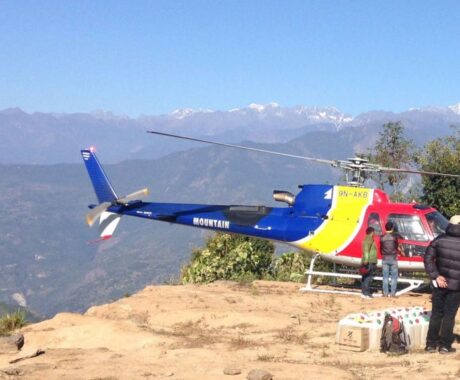
Makalu Base Camp Helicopter Tour
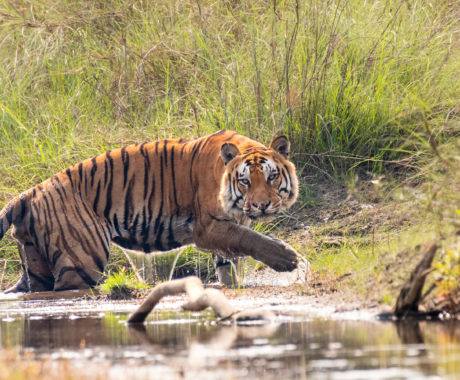
Bardia Tiger Tracking Tour – 7 Days
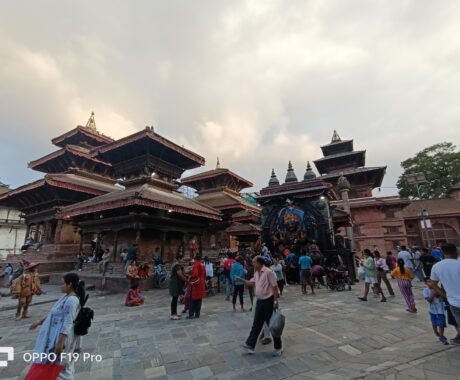
Kathmandu Pokhara and Chitwan Tour
